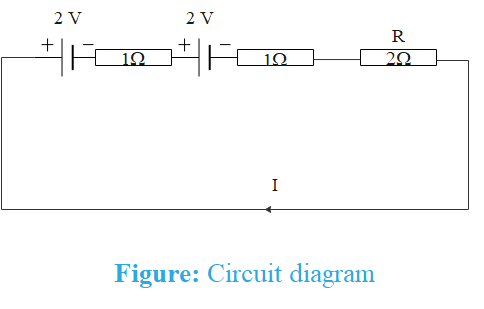Question
Question: Two cells of each 2V and internal resistance \(1\Omega \)are connected in series to a resistor \(R\,...
Two cells of each 2V and internal resistance 1Ωare connected in series to a resistor R=2Ω. What is the maximum possible power consumed by the resistor R?
A. 98W
B. 3.2W
C. 916W
D. 2W
Solution
Draw the circuit diagram as per the details given in the question. When resistances are connected in series, the current is the same through each resistance and total resistance is the sum of all the resistances connected in series.
To determine power consumed by the resistor, first find current through the resistor and then use formula for power.
Formula used:
Net resistance connected in series, R=R1+R2+R3......, Net potential difference of cells connected in series,Vnet=2V+2V=4V and Power, P=I2R
Complete step-by-step answer:
Both cells and resistance are connected in series as shown below

Two cells and one resistor are connected in series. In series, the value of current remains the same.
The net resistance in a series circuit is the sum of the individual resistance of each resistor.
Therefore, the net resistance of this circuit is the sum of internal resistances and resistance of R.
Rnet=1Ω+1Ω+2Ω=4Ω
According to Ohm’s law, the potential through a resistor R is directly proportional to current through it.
V∝I⇒V=IR
Total potential difference in a series circuit is also the sum of the potential difference of each cell connected in series. Therefore,
Vnet=2V+2V=4V
Using Ohm’s law, current through the circuit is
I=RnetVnet
I=4Ω4V=1A
Power in a resistance is given as
P=I2R
Therefore, the power consumed by resistance R is
P=12×2=2Watt
So, the correct answer is “Option D”.
Note: The power given by each cell is 2 Watt.
When resistances are connected in series, the total resistance is the sum of each resistor’s resistance.
When two or more cells are connected in series, the net potential through the series circuit is the sum of potential difference of each cell.
